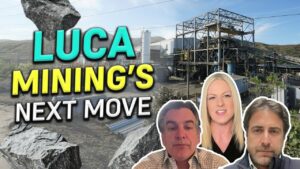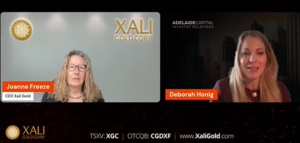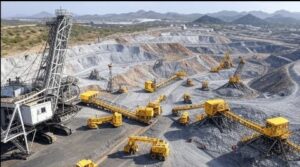HIGHLIGHTS
• First significant gold grades identified at new zone, Loma Bonita, to the east of Mesa de Plata silver discovery area
• Multiple strong, coincident gold and silver assays returned from soil sampling, including:
2.4g/t Au | & | 1.5g/t Au | & | 1.1g/t Au | & | 1.1g/t Au | & | 0.28g/t Au |
97g/t Ag | 61g/t Ag | 36g/t Ag | 33g/t Ag | 104g/t Ag |
• Loma Bonita gold/silver anomaly is hosted in soils developed on vuggy silica similar to that hosting the nearby Mesa de Plata silver deposit
• Loma Bonita partially overlaps and significantly extends the zone of high grade silver mineralisation identified in earlier rock chip sampling (refer ASX release 16 October 2015)
• Azure believes that there is excellent potential for significant high grade, bedrock-hosted gold and silver mineralisation at Loma Bonita
• Diamond drilling at Mesa de Plata is continuing
Azure Minerals Limited (ASX: AZS) (“Azure” or “the Company”) is pleased to report that multiple, strongly anomalous gold and silver assays have been returned from soil sampling to the east of the original Mesa de Plata silver discovery. Results include high gold and silver grades from a previously un-sampled area, as well as from within the area of recently announced high grade silver from rock chip sampling (refer ASX release 16 September 2015).
These results, with grades reporting as high as 2.44g/t Au & 104g/t Ag, indicate potential for this new zone to host significant silver and gold mineralisation within widespread outcropping vuggy silica similar to that which hosts the Mesa de Plata silver deposit.
Azure has called this new zone Loma Bonita (Spanish for Beautiful Hill).
Azure’s Managing Director, Mr Tony Rovira said, “The high precious metal values in the soil samples, including over 2.4g/t Au and 100g/t Ag, are a major development. The silver grades are generally more than double those that were recorded from the soil sampling at the nearby Mesa de Plata discovery, and the high gold assays indicate, for the first time, that this system may have significant gold potential.
“Expanding our exploration out from Mesa de Plata has identified extensive high grades of silver in soil and outcrop, with coincident significant gold values. These results have increased the overall area of surface mineralisation, highlighting the potential for a large, strongly mineralised, epithermal system.
“Exploration is continuing, with close-spaced RC drilling at Mesa de Plata set to start this month, as soon as we have received the required approval, while additional surface exploration to delineate future drill targets at Loma Bonita and further north is ongoing.
“We’re very excited that the Mesa de Plata area continues to deliver new discoveries, and we are surprised that such a large, outcropping, strongly mineralised system has remained unrecognised in a district which has undergone extensive mining and exploration over many decades. Further exploration has the potential to identify more precious metal, and perhaps, base metal mineralisation in this area.”
DETAILS
The Company collected a total of 77 soil samples by using a methodology known as ridge and spur sampling. This method samples along the crests of the highest parts of the local topography in order to detect shallow buried mineralisation with minimal dispersion or contamination.
Samples were collected at approximately 50m spacings along the ridge forming the Mesa de Plata silver deposit as a control measure, and then sampling was expanded out to cover other ridgelines in this northwestern part of the Alacrán project area (see Figures 1 & 2).
Sampling along the Mesa de Plata ridgeline returned consistently anomalous silver grades from 5g/t to 38g/t Ag, thereby confirming the effectiveness of the sampling method. No gold grades above the lower detection limit (<0.005g/t Au) were returned from Mesa de Plata.
The new zone of surface mineralisation at Loma Bonita is about 300m to the east of the Mesa de Plata silver deposit. The soil anomaly is situated on a north and northwest trending ridge which extends for about 750m, and the bedrock beneath the soil is a thick formation of vuggy silica, similar to the unit which hosts the Mesa de Plata silver mineralisation.
Strongly anomalous gold and silver grades were returned from the soil samples over the entire length of the Loma Bonita ridgeline, with maximum values of 2.44g/t Au and 104g/t Ag. Four consecutive samples returned grades greater than 1g/t Au and 30g/t Ag. These silver values are significantly greater than those returned from soil sampling on Mesa de Plata. In addition, the fact that high gold assays were returned from Loma Bonita compared to no anomalous gold on Mesa de Plata is considered very significant.
Azure believes that there is excellent potential at Loma Bonita for significant high grade, bedrock-hosted gold and silver mineralisation.
DRILLING UPDATE
Diamond drilling is continuing at Mesa de Plata. These holes will provide drill core for mineralogical and metallurgical studies of the high grade silver mineralisation and also provide a comparison between diamond core results versus RC results for mineral resource estimation purposes. Two holes have been completed to date, with MDPD-01 twinning the RC hole LM- 09 and MDP-02 twinning LM-06. Azure will provide updates when results are available.
Azure has applied for permission to undertake a close-spaced drilling program at Mesa de Plata, and approval of this application is awaited.
-ENDS-
Information in this report that relates to Exploration Results is based on information compiled by Mr Tony Rovira, who is a Member of The Australasian Institute of Mining and Metallurgy. Mr Rovira is a full-time employee and Managing Director of Azure Minerals Limited. Mr Rovira has sufficient experience which is relevant to the styles of mineralisation and types of deposit under consideration and to the activity which he is undertaking to qualify as a Competent Person as defined in the 2012 Edition of the “Australasian Code for Reporting of Exploration Results, Mineral Resources and Ore Reserves”. Mr Rovira consents to the inclusion in the report of the matters based on his information in the form and context in which it appears.
Information in this report that relates to previously reported Exploration Results has been crossedreferenced in this report to the date that it was reported to ASX. Azure Minerals Limited confirms that it is not aware of any new information or data that materially affects information included in the relevant market announcement.
APPENDIX 1:
ALACRÁN BACKGROUND
Alacrán is located in northern Mexico approximately 50km south of the USA border. The property covers 54km2 of highly prospective exploration ground in the middle of the Laramide Copper Province. This is one of North America’s most prolific copper-producing districts, extending from northern Mexico into the southern United States.
Alacrán lies in close proximity to several large copper mines, including being 15km from the world class, giant Cananea Copper Mine operated by Grupo Mexico. This is one of Mexico’s premier mining districts, with world class production of copper together with significant amounts of gold, silver and molybdenum.
There is excellent access to and within the property, via a sealed highway from Hermosillo, capital of the state of Sonora, and existing mine roads and ranch tracks. The nearby town of Cananea is a mining-friendly jurisdiction with experienced exploration and mining services, as well as physical infrastructure including roads, railway, airport, electrical power and water.
Commercial and artisanal mining occurred within the project area in the early 20th century, ending in 1913 due to the Mexican Revolution. Since that time, Alacrán has seen only limited exploration and its potential for hosting large porphyry copper deposits and smaller high grade precious and base metal deposits remains largely untested by modern exploration techniques.
The Anaconda Copper Mining Company explored the property intermittently from the 1930’s to the 1960’s. Data relating to this work is held in the Anaconda Geological Documents Collection, part of the American Heritage Centre in the University of Wyoming. Azure has visited the library and retrieved copies of numerous technical reports and maps.
Between the 1960’s and the early 1980’s, the Consejo de Recursos Minerales (Mexican Geological Survey) carried out occasional exploration programs, including drilling 6 holes at the Cerro Alacrán prospect in 1970 and undertaking geophysical surveys over the Palo Seco and La Morita prospects in 1981.
Grupo Mexico S.A.B.de C.V. (“Grupo Mexico”) then acquired the project and drilled 26 holes at Cerro Alacrán in the 1990’s. This drilling, which was restricted to an area of approximately 50 hectares, outlined a large body of near-surface, copper oxide and chalcocite (copper sulphide) mineralisation. The size, grade and the extent of this mineralised body is yet to be defined as a mineral resource to JORC standards.
Minera Teck S.A. de C.V. (“Teck”), a Mexican subsidiary of Canadian company Teck Resources Limited, acquired the property from Grupo Mexico in 2013 and undertook data compilation and limited surface exploration.
Azure Minerals acquired the rights to the project in December 2014 through its fully owned Mexican subsidiary Minera Piedra Azul S.A. de C.V.
Azure has signed an Agreement with Teck to acquire 100% of the property, subject to an underlying back-in right retained by Teck and a 2% NSR retained by Grupo Mexico. Teck is Canada’s largest diversified resource company. Grupo Mexico is Mexico’s largest and one of the world’s largest copper producers.
You may view Figures in the Original Article: http://www.azureminerals.com.au/azs//assets/2015/10/1486755-3.pdf

















